1 Nursing Informatics and Informatic Basics
Laura K. Garner-Jones
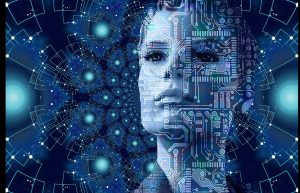
Introduction: Nursing Informatics
We are in a time of explosive technology throughout the world. Artificial Intelligence (AI) is impacting healthcare and shortages of workforce and supplies reduce access to services, delay care, and contribute to caregiver burnout and strain. Technology is a way for interprofessional practitioners to address healthcare issues. We hear more and more about the depth of the thread of technology, science, communication, and knowledge in many realms identified as ‘informatics’.
Informatics is coined as an umbrella concept, yet, as nurses, do we understand the meaning and impact of informatics in what we do? A basic definition of informatics is using information systems, processing information, using computer science to interface, and then gaining new knowledge to apply. Yet, it is so much more when we recognize how it interfaces with so many disciplines, and even in our daily lives. Informatics is much more than just information systems, processing, and computer science. It is important to recognize that informatics now covers a plethora of concepts, so an understanding of the basics of computer operations and computer science is necessary.
The following is an overview of the nursing informatics portions of this book:
Chapter 1 – Nursing Informatics and Informatics Basics
Chapter 2 – Health IT and Healthcare Technology
Chapter 3 – The Future of Healthcare Technology
Chapter 4 – Information Literacy and Management
Chapter 5 – Digital Patient Engagement
Chapter 6 – Electronic Health Records & Clinical Decision Support
Chapter 7 – Confidentiality and Security
Chapter 1 Overview
- Clinical informatics definition and concepts
- Nursing informatics and the role of nursing informatics in safe, quality patient care
- Overview of computer literacy
- Computer basics
Introduction
Informatics can be seen in nearly every aspect of patient care. In general, nurses respond to health problems and advocate for patients. In doing so, nurses utilize technical skills, interpersonal skills, and cognitive skills. When performing any of these nursing skills, nurses must manage data and information, so informatics concepts are essential to nursing practice.
The American Association of Colleges of Nursing (AACN), a nursing education accreditation body, recognizes that informatics and technology support healthcare processes and clinical thinking and have a positive impact on patient outcomes. Therefore, basic informatics competencies are necessary for effective nursing practice. The following competencies for informatics and healthcare technology are expected at the Bachelor’s level (AACN, 2021).
AACN Essentials: Core Competencies for Professional Nursing Education
Domain 8: Informatics and Healthcare Technologies:
Information and communication technologies and informatics processes are used to provide care, gather data, form information to drive decision-making, and support professionals as they expand knowledge and wisdom for practice. Informatics processes and technologies are used to manage and improve the delivery of safe, high-quality, and efficient healthcare services in accordance with best practice and professional and regulatory standards.
Informatic Competencies Necessary for Safe Nursing Practice:
- 8.1 Describe the various information and communication technology tools used in the care of patients, communities, and populations.
- 8.2 Use information and communication technology to gather data, create information, and generate knowledge.
- 8.3 Use information and communication technologies and informatics processes to deliver safe nursing care to diverse populations in a variety of settings.
- 8.4 Use information and communication technology to support documentation of care and communication among providers, patients, and all system levels.
- 8.5 Use information and communication technologies in accordance with ethical, legal, professional, and regulatory standards, and workplace policies in the delivery of care.
Clinical Informatics
Clinical informatics is a broad term that includes all medical and health specialties and addresses the ways health information technology (examples: health information databases, electronic health records, laboratory systems, radiology imaging systems, point of care technologies, barcode medication administration systems, etc.) are used in the day-to-day operations of patient care (Carter-Templeton et al., 2025).
The goal of clinical informatics is to improve the health of populations, communities, families, and individuals by optimizing information management and communication. As part of our role as members of the healthcare team, nurses should utilize health information technology to capture information and share it with the team. When we do so, patient care is positively impacted. In fact, clinical informatics optimization can solve complex issues within healthcare systems, including fragmentation, access to care, and care of special populations (Alexander et al., 2019).
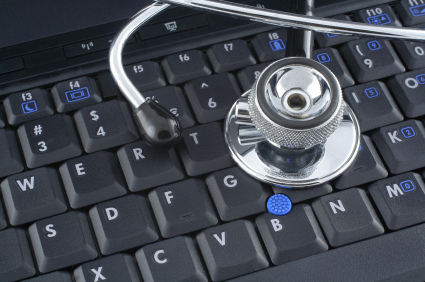
Clinical Informatic Concepts: Data, Information, Knowledge, Wisdom (DIKW)
DIKW is an acronym that stands for Data, Information, Knowledge, and Wisdom (Figure 1.1). DIKW is a framework used to explain how understanding and meaning are developed from raw data. Each level of DIKW builds upon the previous one, ultimately leading to more informed decision-making.
Data
Data are small pieces of information, such as individual facts, values, and measurements. An example of “data” is a single pulse rate. By itself, the single pulse rate may or may not be important, but when that single pulse rate is combined with a full set of vital signs (much more data) or a trend of single pulse rates, meaning can be found.
Information
Information is organized, structured, and condensed data. In healthcare settings, information is when nurses and other healthcare providers take data, and using their education and experience, they process the data in a clinical context that has meaning (Carter-Templeton et al., 2025). An example of “information” is a 12-hour pulse rate trend (12 pieces of “data”). Information can be used to plan care for patients, improve the quality of care, prevent medical errors, increase efficiency, and potentially reduce unnecessary costs (Alexander et al., 2019).
Figure 1.1 – DIKW
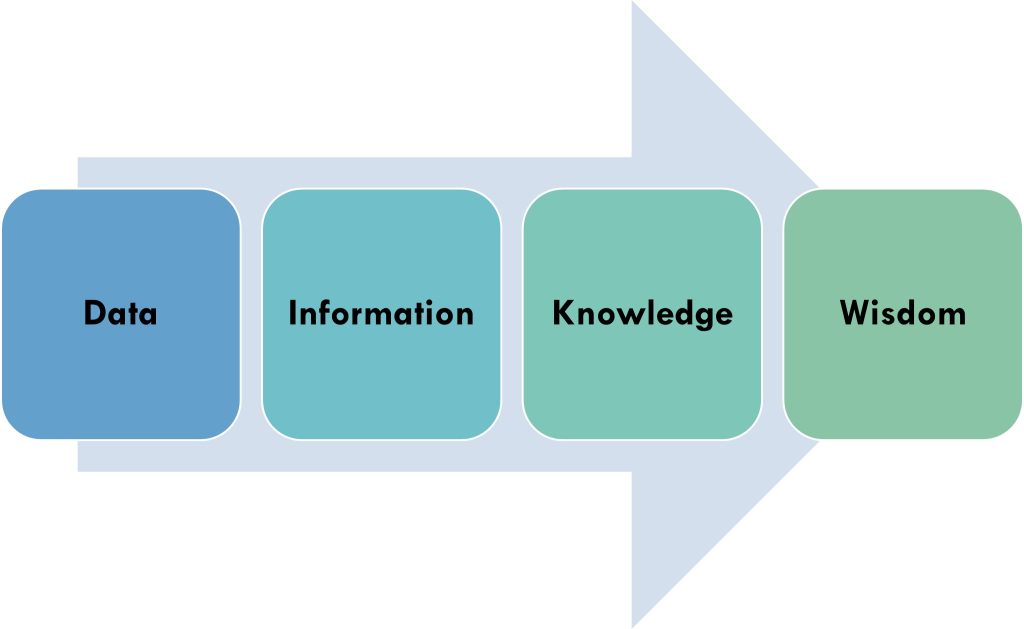
Knowledge
Wisdom
Wisdom is the use of knowledge and experience applied to complex problems, specifically, the appropriate application of knowledge (knowing when and how to apply knowledge). Nurses will 1) assess and recognize the situation, 2) apply their clinical knowledge and experience, and 3) integrate the patient’s values and preferences to determine the most appropriate nursing intervention or action (McGonigle & Mastrian, 2025). An example of wisdom is taking the knowledge that a trauma patient who is less responsive, has low blood pressure, and a high pulse rate needs volume replacement and putting that knowledge into action.
Advancement in the DIKW Framework: From Data to Wisdom Using Technology
Healthcare technology strives to support the patient care decisions that healthcare providers make. Using technology in healthcare can increase standardization and efficiency of clinical workflows, and reduce errors (Holmgren et al., 2023). Technology continues to advance systems that can support patient care by moving data to information (health information technology), information to knowledge (clinical decision support systems), and knowledge to wisdom (expert systems). See Figure 1.2.
Storage of “data” and the movement of data into “information” are supported by modern-day health information technology (Health IT). Health IT is a term that is used for the electronic health systems that healthcare professionals and patients use to store, share, and analyze health information (Office of the National Coordinator for Health Information Technology, n.d.). Health IT is also required for person-centered care and requires consistent user input, proper process, and quality management (AACN, 2021).
Within Health IT, Clinical Decision Support Systems (CDSS) are integrated into the electronic health record (EHR). CDSS is a technology tool that provides healthcare providers with knowledge and person-specific information to enhance decision-making (Wikipedia, 2020). Utilization of CDSS improves patient outcomes, reduces medical errors, and enhances clinical efficiency by providing evidence-based recommendations (Chen et al., 2023). CDSS can facilitate moving “information” to “knowledge.” CDSS organizes various data and notifies clinicians of variabilities. An example of a CDSS is an EHR “flag” that will alert healthcare providers to potential patient issues. Flags can alert clinicians of medication contraindications (barcode medication administration), abnormal vital signs, laboratory results out of normal range, and patients who should be assessed for sepsis, just to name a few. CDSS bring the data and information together to form “knowledge.” Although CDSS is not human knowledge, it is an important Health IT tool and can improve patient safety by prompting healthcare providers (McBride & Tietze, 2023).
Unlike knowledge, wisdom is a higher-order attribute that nurses bring to patient care and is very difficult for Health IT to replicate. Despite this, moving “knowledge” into “wisdom” is advancing at a rapid pace. “Expert systems” is Health IT that attempts to mimic human “wisdom.” The use of advanced technology like artificial intelligence and machine learning can generate “wisdom-like” predictions of patients at risk for suicide based on data collected through social online activities (Chatterjee et al., 2023). Expert systems can also analyze and recognize abnormalities in medical imaging that are not always apparent to the human eye and provide a diagnosis (Kurtzweil, 2024). Expert systems are still being tested and researched, but healthcare may be transformed by expert systems in the future (McBride & Tietze, 2023).
Figure 1.2 – Advancement from Data to Wisdom Using Technology

Nursing Informatics
Nursing Informatics (NI) is a nursing specialty that integrates nursing science, computer science, and information science (Table 1.1 and Figure 1.3) to manage and use data, information, knowledge, and wisdom in nursing practice (American Nurses Association, 2023).
Table 1.1 – Nursing Science, Computer Science, and Information Science Defined
| Term | Definition |
|---|---|
| Nursing Science | The “art of nursing.” It is defined as the ethical application of knowledge acquired through education, research, and practice to provide services and interventions to patients to maintain, enhance, or restore their health and to acquire, process, generate, and disseminate nursing knowledge to advance the nursing profession (McGonigle & Mastrian, 2025). |
| Computer Science | Study of the theory, design, implementation, and performance of computer software and computer systems (University of Maine, n.d.). |
| Information Science | A field that revolves around the management of information in any form (Association for Information Science and Technology, 2025). Management of information can include, but is not limited to, collecting, classifying, analyzing, storing, retrieving, moving, disseminating, and protecting. |
Figure 1.3 – Model of Nursing Informatics
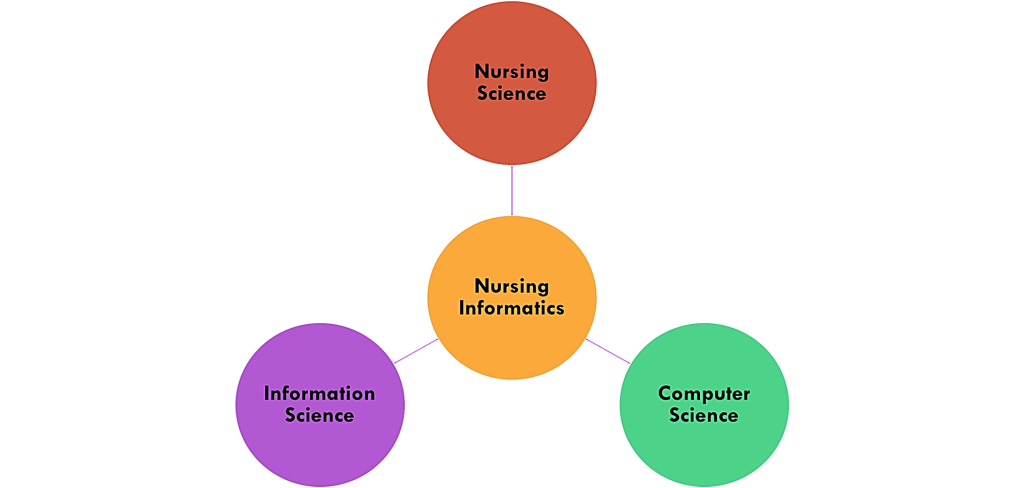
Much of the behind-the-scenes technology that allows hospitals to function is informed by nurse informaticists. A nurse informaticist is a licensed nurse who manages and implements healthcare technologies in an effort to advance patient care, safety, and improve outcomes (University of Providence, 2024). A nursing informaticist’s role is to translate between three different “languages”: “nurse,” “information technology,” and “hospital administrator/business analyst” (Hess & Alper, 2024).
Watch this short video that explains the role of a nurse informaticist.
The Role of Nurse Informaticists
Nurses are natural problem-solvers, and this is true in the nurse informatic role as well. Nursing informatic professionals practice with other healthcare professionals and work in an interdisciplinary way, effectively capturing data and bridging the gap between clinical practice and information systems. According to the American Nurses Association (2023) and Nurse.com (2024), nurse informaticists use creative technology-driven solutions to:
- Enhance communication amongst healthcare professionals and consumers (secure messaging, digital records, telehealth, virtual health).
- Improve patient care, safety, and outcomes (EHR facilitates comprehensive and accurate patient information, medication administration tasks, & data analytics).
- Streamline workflows (automating routine documentation, improving efficiency, reducing administrative burdens).
- Enable data-driven decision-making (access to real-time clinical data & data analysis can help identify patterns, predict outcomes, and tailor interventions).
- Support education, quality improvement, and research (data sets enable an investigation of trends and outcomes).
Computer Literacy
Computer literacy is defined as the knowledge and ability to use computers and related technologies efficiently and effectively (Illinois State Board of Education, 2022). Nurses are expected to provide safe, competent, and compassionate care in an ever-changing and evolving technical and digital world. Unfortunately, not all nurses are fully prepared to utilize advanced digital tools and technology to support patient care and evidence-based practice (The Tiger Initiative, 2006).
The Technology Informatics Guiding Education Reform, or TIGER Initiative (2006), was formed to bring together nursing stakeholders to develop a strategic plan for improving nursing practice, education, and patient care through the use of Health IT. Following an extensive review of the literature and a survey of education, research, and nursing practice groups, the TIGER Initiative determined that the following informatic competencies were necessary for all practicing nurses:
-
- Basic Computer Literacy
- Information Literacy
- Information Management
The next section of Chapter 1 will review computer basics; Chapter 4 will review information literacy and information management.
Computer Basics
A computer is an electronic information-processing machine that is used as a tool to manipulate data and information. Simply put, computers are input-output systems (Figure 1.4). Computers accept data input, process and store data, and then use output devices to allow the user to visualize and hear the processed data and information (McGonigle & Mastrian, 2025).
Figure 1.4 – The Computer as an Input-Output Device
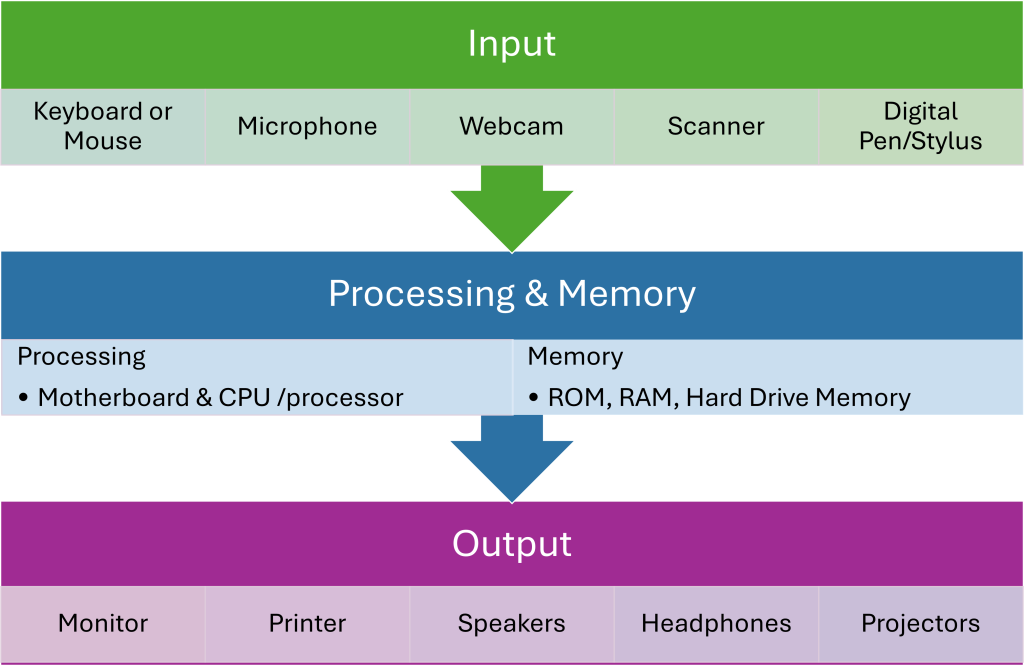
How a computer functions is similar to how we process information as humans. We take in information through input devices (eyes, ears, nose), process that information and utilize memory with our brain, and then use output devices (mouth, movement) to share information with other humans (Figure 1.5).
Figure 1.5 – Comparison of Input-Output Device to Human Features
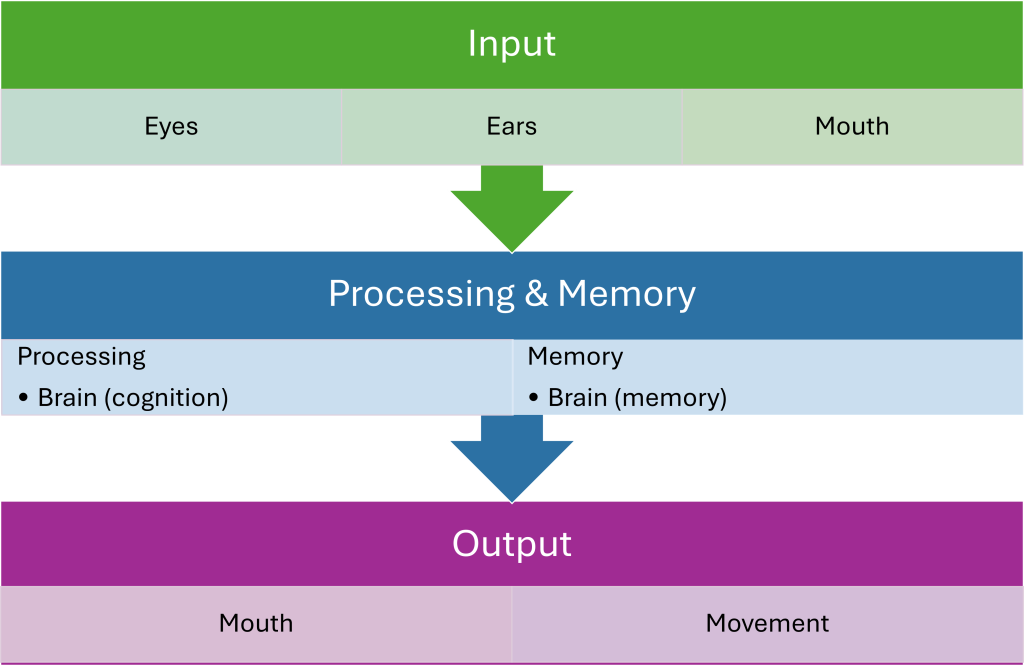
Computer Components
Most of the listed 16 computer parts (Figure 1.6) are critical in the operation of the computer terminal in the hospital and with personal computers (PCs), including laptops, smartphones, tablets, and other devices for personal use, as well as those used in providing healthcare.
Figure 1.6 – Personal Computer Exploded 6.5VG
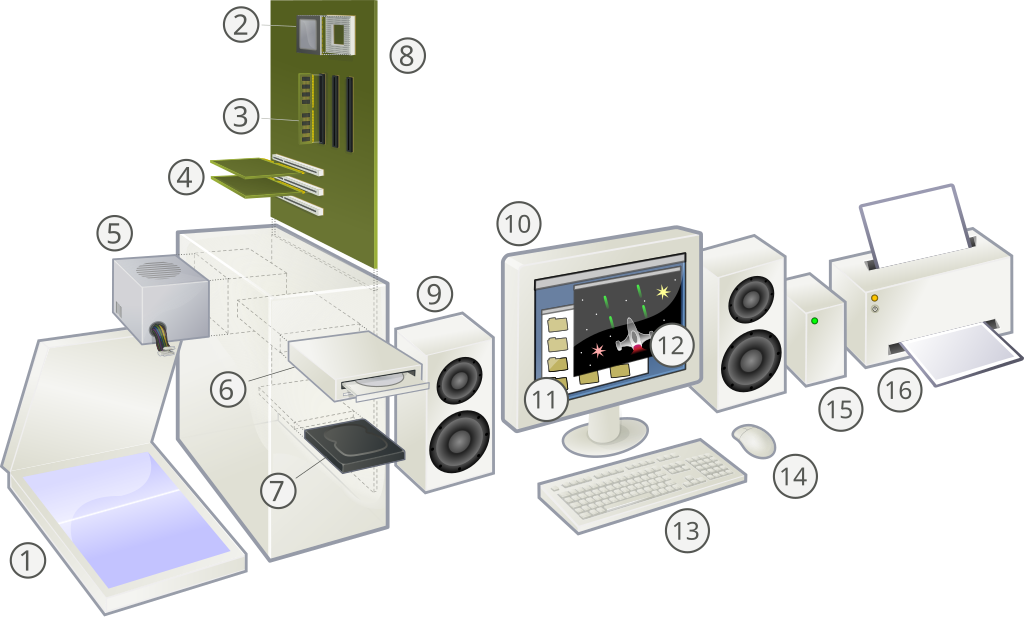
| 1 | Scanner |
|---|---|
| 2 | CPU (Microprocessor) |
| 3 | Main memory (RAM) |
| 4 | Expansion cards |
| 5 | Power supply unit |
| 6 | Optical disc drive |
| 7 | Hard disk drive (HDD) |
| 8 | Motherboard |
| 9 | Speaker |
| 10 | Monitor |
| 11 | System software |
| 12 | Application software |
| 13 | Keyboard |
| 14 | Mouse |
| 15 | External hard disk |
| 16 | Printer |
Primary Memory
The computer’s memory is divided into random-access memory (RAM) and read-only memory (ROM). RAM is temporary storage for data that is being created. Unless the user saves the data in a permanent location, RAM storage is lost when the program is closed or the computer is turned off. ROM storage is permanently saved on the computer’s hard drive. It remains when the computer is off (Carter-Templeton et al., 2025).
When computers are slow, it may be related to not enough ROM to manage all the software or not enough RAM to manage what needs to be saved.
How much memory a computer has depends on the capacity, or how many “bytes” are listed under RAM (aka: memory) and how many “bytes” are listed under ROM (aka: hard drive or “storage). A bit is the smallest piece of data memory and is depicted as a 1 or a 0. Bits make up the computer’s binary system. A byte is a portion of memory (8 bits) that is used to indicate computer memory or storage capacity. Bytes are described in units of megabytes (MB) – 1 million bytes; gigabytes (GB) – 1 billion bytes; or terabytes (TB) – 1,000 GB (McGonigle & Mastrian, 2025).
Secondary Memory
Storage devices are considered secondary memory and are connected to computers or devices using peripherals. Storage devices continue to evolve just as technology evolves (Figure 1.7).
Figure 1.7 – Secondary Storage
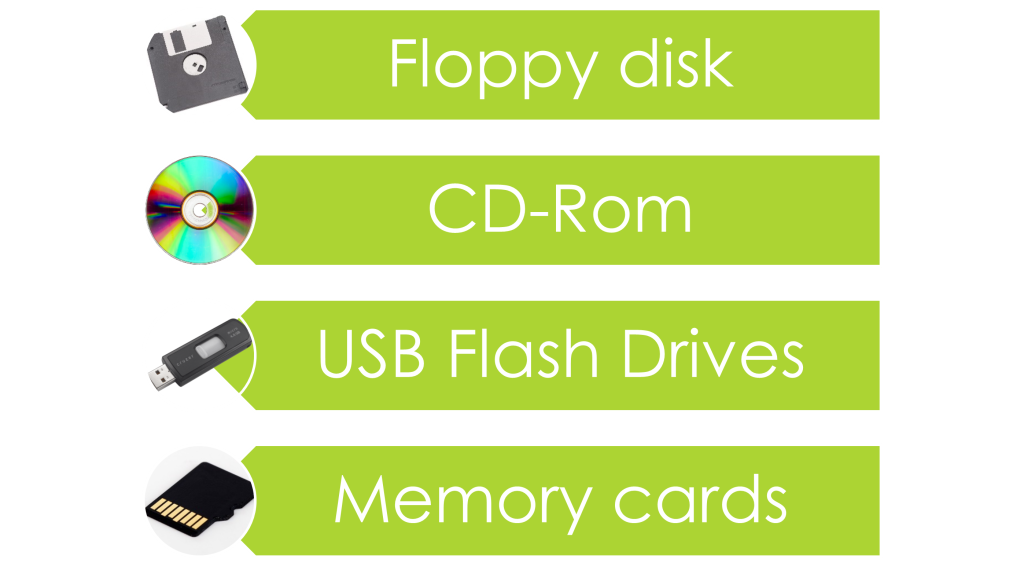
Software
Software is an application program developed to help the end user accomplish functions like:
-
- Writing, spreadsheets, presentations, and scheduling (Office Suite or WordPerfect Suite).
- Drawing, painting, multimedia (Adobe Photoshop or InDesign, Illustrator, Microsoft Movie Maker, WordPress).
- Networking & communicating (Outlook: Email; Google Chrome & Microsoft Edge: Internet browsers; Zoom & Google Meet: Conferencing software). (McGonigle & Mastrian, 2025).
Operating System (OS) software: Fundamental software that manages a computer’s operation and provides an interface for software applications to work with computer hardware (Windows, Linux, Mac OS, Android, iOS). Some of the functions of the “OS” include managing files and storage, running applications, coordinating memory, and handling input/output.
Networks, Servers, and the Cloud
Computers can be connected to other computers, systems within an organization, to other organizations using the Internet, and even to Cloud servers.
Networks
Networks allow the sharing of computer and software resources. Computers on a network are called nodes, and computers can be connected through an Ethernet cable or wirelessly using WIFI, where networks use radio waves for high-speed internet access.
- Local Area Networks (LAN): A network that connects devices in a single location or business. This can also be the case in our own home, such as having a private network.
- Metropolitan Area Network (MAN): A wider area, like a large organization or geographic area. Physical connections over or between several existing LAN structures. A communication system in a university with multiple buildings is an example.
- Wide Area Network (WAN): The largest and most far-reaching network of computers in a country, continent, or the internet.
- A virtual private network (VPN) provides secure connectivity between networks and remote computers/devices using encryption, which transforms information/data into a code to prevent unauthorized access (McGonigle & Mastrian, 2025).
Servers
Most networks work through a centralized main server where files are stored and backed up. Some advantages to servers include increased security and a decrease in cost due to the ability of multiple computers to use a single software license. Unfortunately, if the server goes down, the entire network will be offline.
The Cloud
Cloud computing refers to storing and accessing data and programs over the internet instead of using a computer’s hard drive. Examples of cloud computing are Google Drive, Dropbox, and iCloud.
Utilizing the cloud, people can also work together, or “collaborate” on documents and online projects in real-time and simultaneously from any location using the internet. Examples of cloud collaboration are Google Docs & Microsoft Teams. Unlike traditional methods of emailing files or working alone, this approach can enhance collaboration & sharing of resources, increase productivity, and decrease costs. (McGonigle & Mastrian, 2025).
Watch this short video for a simple explanation of cloud computing.
Conclusion
Nursing informatics is more than just understanding how to use a computer or electronic health record; it is a dynamic integration of nursing science, computer science, and information science that empowers nurses to deliver safer, more efficient, and more informed care.
In an increasingly digital healthcare environment, nurses are expected to collect, analyze, and apply data to make sound clinical decisions. From foundational computer literacy to advanced systems like clinical decision support and artificial intelligence, informatics tools shape how nurses communicate, document, and interact with patients and the broader healthcare team.
As this chapter has outlined, informatics is deeply woven into the everyday practice of nursing. The DIKW framework illustrates how data becomes meaningful when transformed into wisdom through clinical experience and technological support. Likewise, the role of the nurse informaticist highlights how this specialty connects technology with patient care to improve outcomes and optimize workflows. Understanding basic computer operations, networks, software, and storage systems builds the foundation for engaging with more complex informatics systems throughout your nursing practice and career. Developing informatics competencies is not optional; it is essential for today’s nurse. By embracing these tools and concepts, nurses can lead innovation and continue to advocate for patients in a technology-driven world.
References:
-
American Association of Colleges of Nursing (2021). The essentials: Core competencies for professional nursing education. https://www.aacnnursing.org/Portals/0/PDFs/Publications/Essentials-2021.pdf
-
Alexander, S., Frith, K. H., & Hoy, H. (2019). Applied clinical informatics for nurses (2nd ed.). Jones & Bartlett Learning.
-
American Nurses Association. (2023, July 5). What is nursing informatics? https://www.nursingworld.org/content-hub/resources/nursing-resources/nursing-informatics/
-
Association for Information Science and Technology. (2025). What is information science? https://www.asist.org/student-resources/what-is-information-science/
-
Carter-Templeton, H., Alexander, S., & Frith, K. (2025). Applied clinical informatics for nurses (3rd ed.). Jones & Bartlett Learning.
-
Chatterjee, M., Kumar, P., Samanta, P., & Sarkar, D. (2022). Suicide ideation detection from online social media: A multi-modal feature based technique suicide ideation detection from online social media: A multi-modal feature-based technique. International Journal of Information Management Data Insights, 2(2), https://doi.org/10.1016/j.jjimei.2022.100103
-
Chen, Z., Liang, N., Zhang, H., Li, H., Yang, Y., Zong, X., Chen, Y., Wang, Y., & Shi, N. (2023). Harnessing the power of clinical decision support systems: Challenges and opportunities. Open Heart, 10(2), e002432. https://doi.org/10.1136/openhrt-2023-002432
-
Hess, S., & Alper, C. (2024). Nursing informatics: The vital nursing link between technology and patient care. HCA Healthcare Journal of Medicine 5(5): 513-516. doi: 10.36518/2689-0216.2003
-
Holmgren, A. J., McBride, S., Gale, B., & Mossburg, S. (2023, March 29). Technology as a tool for improving patient safety. Agency for Healthcare Research and Quality – Patient Safety Network. https://psnet.ahrq.gov/perspective/technology-tool-improving-patient-safety
-
Illinois State Board of Education. (2022). Computer literacy. https://www.isbe.net/Documents/Comp-Literacy-Fact-Sheet.pdf
-
Kurtzweil, J. (2024, March 4). New AI model draws treasure maps to diagnose disease. University of Illinois Urbana-Champaign. https://beckman.illinois.edu/news/article/2024/03/04/new-ai-model-draws-treasure-maps-to-diagnose-disease
-
McBride, S. & Tietze, M. (2023). Nursing informatics for the advanced practice nurse: Patient safety, quality, outcomes, and interprofessionalism (3rd ed.). Springer.
-
McGonigle, D., & Mastrian, K. G. (2025). Nursing informatics and the foundation of knowledge (6th ed.). Jones & Bartlett Learning.
-
Nurse.com. (2024, June 19). What is nursing informatics? https://www.nurse.com/nursing-resources/definitions/what-is-nurse-informatics/
-
Office of the National Coordinator for Health Information Technology. (n.d.). Health IT: Advancing America’s healthcare. https://www.healthit.gov/sites/default/files/pdf/health-information-technology-fact-sheet.pdf
-
The Tiger Initiative. (2006). The TIGER summit. https://www.tigersummit.com/uploads/3.Tiger.Report_Competencies_final.pdf
-
University of Maine. (n.d.). Computer science and computing-related fields: What are they, and what’s the difference? https://www.asist.org/student-resources/what-is-information-science/
-
University of Providence. (2024, December 30). Healthcare in five: Nurse informaticist. https://www.uprovidence.edu/about/news/nurse-informaticist/
-
Wikipedia. (2020, January). Clinical decision support system. https://en.wikipedia.org/wiki/Clinical_decision_support_system
-
Wikipedia. (2023, July, 29). Artificial intelligence. https://en.wikipedia.org/wiki/Artificial_intelligence
-
Wikipedia (2025, May 24). Health informatics. https://en.wikipedia.org/wiki/Health_informatics
Media Attributions:
-
Itsnotlettingme. (2017, June 12). What is cloud computing? [Video] YouTube. https://www.youtube.com/watch?v=dmPz1KGefU4
-
Laptop by jfcherry is licensed under a CC BY-SA 2.0 license.
-
Personal computer, exploded 6.SVG. is by HeretoHelp is licensed under CC BY-SA 3.0
-
This Week’s Health. (2021, March 25). An introduction to nursing informatics and its usefulness for healthcare [Video]. YouTube. https://www.youtube.com/watch?v=D3UBs4E2akg
-
Trace Board Technology Science Grid Light Just by Doodlebug is licensed under a Public Domain license.
OER Resources Utilized in this Section:
- Clark, K. (2023). The health informatics guide: A beginner’s guide to systems. Universities at Shady Grove Pressbooks. https://shadygrove.pressbooks.pub/informatics/ Creative Commons Attribution-NonCommercial 4.0 International License
Artificial intelligence (AI) is the intelligence of machines or software, as opposed to the intelligence of human beings or animals.
At its core, informatics is the science of information and all its aspects – how it’s stored, processed, communicated, and used. It is mainly thought of today as computerized information, but can also apply to information stored, communicated and used on paper, audio tape, or even in someone’s brain.
Though a current informatics definition is now usually linked with a scientific discipline such as medical informatics or healthcare informatics, the term also can apply to more diverse areas such as library informatics, financial, or even sports.
With the increase of electronic health records, the healthcare field has become one of the dominant users of informatics. As today’s seemingly infinite amount of data continues growing, informatics is used to help process, analyze, and communicate large chunks of data while seeking clues to support and sustain public health and enhance the quality of care in the field of biomedical informatics.
Saba, V. K., & McCormick, K.A. (2015). Essentials of nursing informatics (6th ed). McGraw Hill.
Broad term that includes all medical and health specialties and addresses the ways health information technology are used in the day-to-day operations of patient care (Alexander, Frith, & Hoy, 2019).
Individual facts, values, and measurements (a single pulse rate).
Organized, structured, and condensed data.
Information that has been synthesized by a provider.
Use of knowledge and experience applied to complex problems, specifically, the appropriate application of knowledge (knowing when and how to apply knowledge).
Health IT is a term that is used for the electronic health systems that healthcare professionals and patients use to store, share, and analyze health information.
A technology tool that provides healthcare providers with knowledge and person-specific information to enhance decision-making.
Health information technology that attempts to mimic human "wisdom" through the use of advanced technology like artificial intelligence and machine learning.
A nursing specialty that integrates nursing science, computer science, and information science to manage and use data, information, knowledge, and wisdom in nursing practice.
The ethical application of nursing knowledge acquired through education, research, and practice to provide services and interventions to patients to maintain, enhance, or restore their health and to acquire, process, generate, and disseminate nursing knowledge to advance the nursing profession.
Study of the theory, design, implementation, and performance of computer software and computer systems.
Field that revolves around the management of information in any form.
A licensed nurse who manages and implements healthcare technologies in an effort to advance patient care, safety, and improve outcomes.
Temporary storage for data.
Storage of data that is permanent.
Smallest piece of data memory.
A system used by computers, a numeric system that uses two symbols, 0 and 1.
A portion of memory (8 bits) that is used to indicate computer memory or storage capacity.
An application program developed to help the end user accomplish functions.
A network that connects devices in a single building.
A wider area, like a large organization or geographic area. Physical connections over or between several existing LAN structures.
The largest and most far-reaching network of computers in a country, continent, or the internet.
A network that provides secure connectivity between networks and remote computers/devices using encryption.
Storing and accessing data and programs over the internet instead of using a computer's hard drive.

